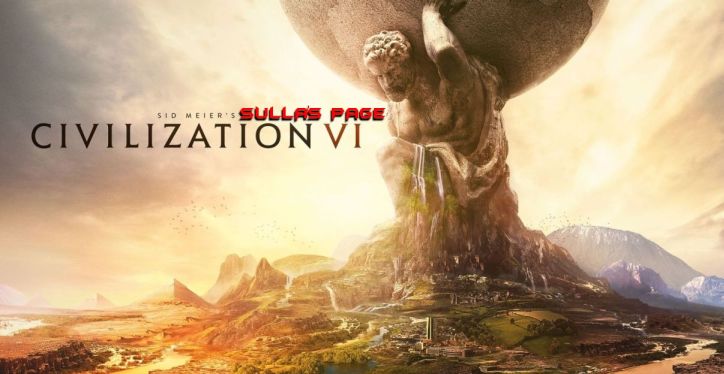

I played the first 100 turns in a single Livestreaming session. When I picked back up again the next day, I was almost immedately greeted by this diplomatic message:
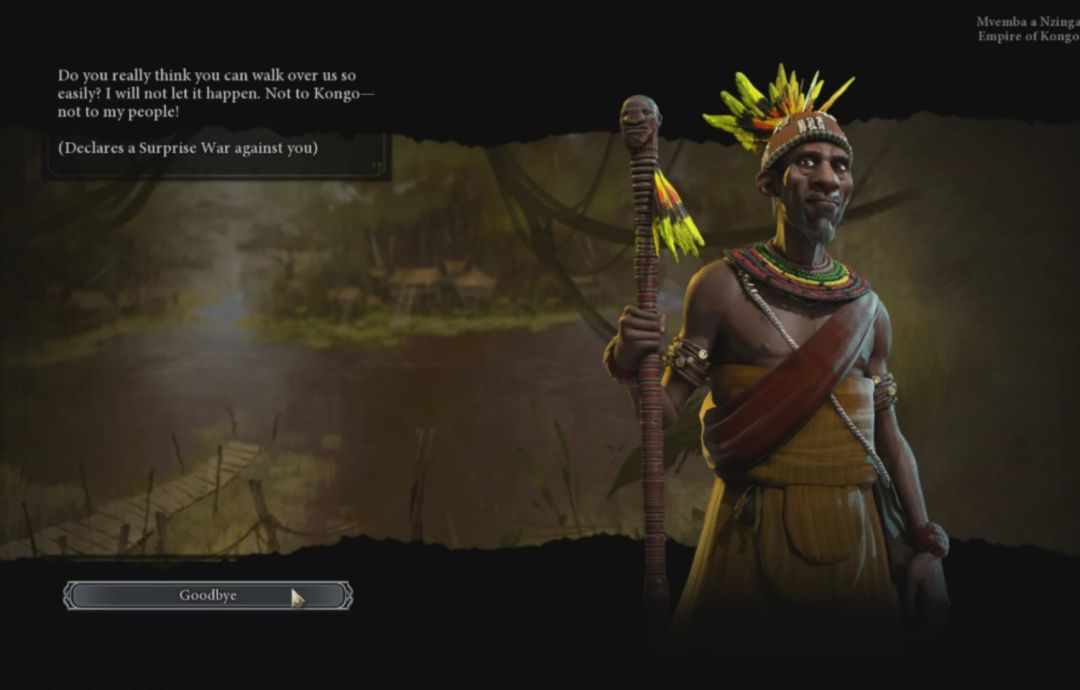
Mvemba decided to launch a surprise attack. I wasn't planning on doing much warring in this game, and had mostly been trying to befriend the other AIs. Trajan in particular loved me, since he likes "large empires" and mine was (somehow) the largest in the world. Mvemba's agenda seems to revolve around religion, and I didn't have one at all, so I'm not sure what ticked him off. Perhaps something in his hidden agenda? I had seen some of his units sailing around and didn't think that he would be foolish enough to launch an actual war. I mean, look for yourself:

Really?! Is that the best you've got? A bunch of embarked warriors?  I had no military to speak of, and I was still extremely confident that I could handle this. I built a few more archers and started shooting down the Kongolese warriors as they sailed past. They might have been able to capture Sheffield if they had simply landed and attacked, but of course that was too complicated for the AI to handle. Instead, Mvemba kept shuffling his units around, not attacking, not pillaging, just moving back and forth with no particular goal in mind. While he did that, my archers kept pincushioning them until they were all dead. Very, very sad. I guess that Prince difficulty isn't high enough to get a military challenge. I probably have to dial up the AI production bonuses until they can carpet the map with units. No, strike that; the AI does build a fair number of units, it just doesn't *DO* anything with them. The Civ3 AI was as dumb as a brick, but it could put its units into a stack and throw them at the player. When they would throw one of these stacks together and invade, you had to do something about it, and fast. The AI in Civ5 and Civ6 is just crippled by the One Unit Per Tile rules, and I don't see much that can be done about it. This is the one carryover mechanic from Civ5 that I truly hate, and I doubt it's ever going away. Frustrating.
I had no military to speak of, and I was still extremely confident that I could handle this. I built a few more archers and started shooting down the Kongolese warriors as they sailed past. They might have been able to capture Sheffield if they had simply landed and attacked, but of course that was too complicated for the AI to handle. Instead, Mvemba kept shuffling his units around, not attacking, not pillaging, just moving back and forth with no particular goal in mind. While he did that, my archers kept pincushioning them until they were all dead. Very, very sad. I guess that Prince difficulty isn't high enough to get a military challenge. I probably have to dial up the AI production bonuses until they can carpet the map with units. No, strike that; the AI does build a fair number of units, it just doesn't *DO* anything with them. The Civ3 AI was as dumb as a brick, but it could put its units into a stack and throw them at the player. When they would throw one of these stacks together and invade, you had to do something about it, and fast. The AI in Civ5 and Civ6 is just crippled by the One Unit Per Tile rules, and I don't see much that can be done about it. This is the one carryover mechanic from Civ5 that I truly hate, and I doubt it's ever going away. Frustrating.
Honestly, the single biggest thing that would help the AI at warfare right now is making them more aggressive. Have the AI launch suicide attacks, that's totally fine. The AI will always have a production edge on higher difficulty levels, they can afford losses. Currently, the AI seems incredibly timid, afraid to push any kind of attack in earnest, and as a result their units shuffle around aimlessly while getting shot to death. If they would push forward and actually attack, they would be much more of a threat. That can't be too tough to implement, right? Having them attack whenever they have a chance to do damage? Predictability is fine, they simply need to use their units to launch actual assaults.
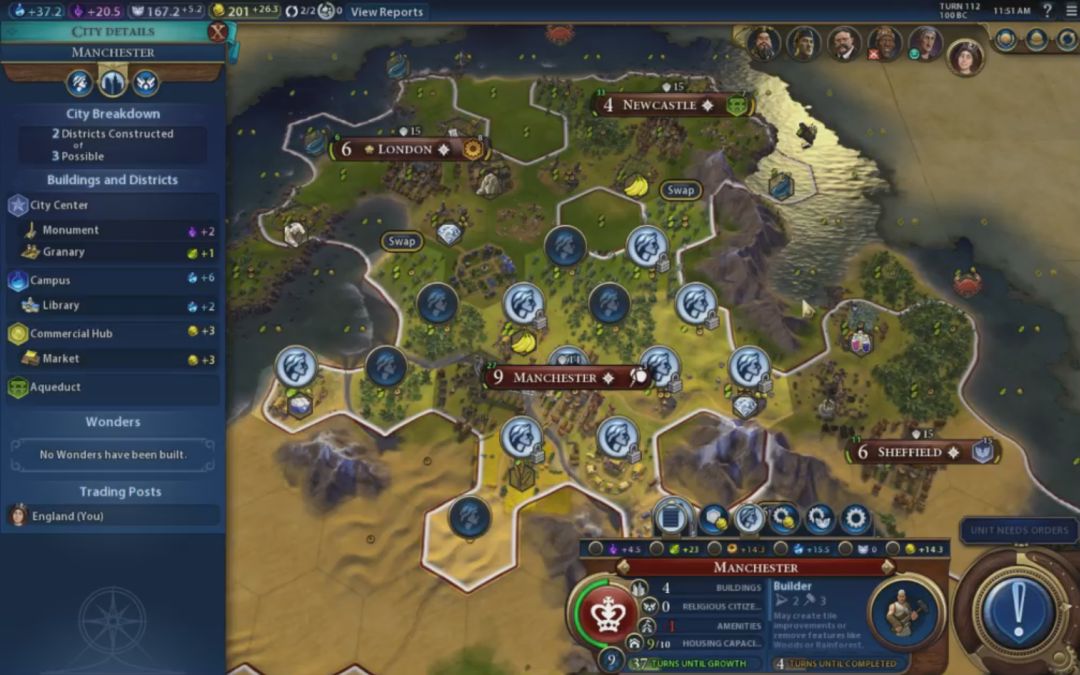
On a more positive note, here's an example of Civ6 working as intended. Manchester was developing in splendid fashion, with two districts completed and infrastructure proceeding apace. This city breakdown screen is very helpful, and it's too bad that it's hidden here in this submenu. This city had a well placed Campus district for +3 beakers, and I was running the policy that doubles Campus adjacency bonuses (Natural Philosophy) to take that up to +6 beakers. The general formula is that 1 population point = 0.7 beakers/turn and 0.3 culture/turn. That Campus was therefore worth about 8.5 population points in science, essentially doubling the beaker output of the city. This is a good example of how Civ6 allows the players to focus on expansion, claiming science and culture via total population, or can build upwards with districts and more infrastructure. Expansion is always going to be better in the long run, but there's only so much land to claim, and building upwards leads to wonders and Great People that may be able to swing the game in other ways. (Lots of the techs and civics get boosted by Great People or wonders in some fashion, potentially saving a lot of beakers/culture.) The city building in this game is excellent, even with all of the buggy and unbalanced stuff elsewhere. It's good enough to keep me coming back to Civ6 despite the various other headaches.
Similarly, check out the tile yields at Manchester. They are small but should be visible when looking closely. After Civ5 neutered tile yields and made the gameplay bland and uninteresting, genuine honest-to-goodness tile yields are back in force again for Civ6. The basic terrain types remain the same, with grassland = 2 food / 0 production and plains = 1 food / 1 production. The terrain modifiers work differently, however, with hills now +1 production and rainforest now +1 food, with forests remaining +1 production as before. In other words, hills are essentially always better than non-hills now, with the one restriction being that hills can't be farmed until late in the game. Hills are particularly great because they can be mined, for +1 production at the start of the game, +2 production after Apprenticeship tech, and +3 production after Industrialization. In other words, a plains hill tile starts at 1/2, then becomes 1/3 after being mined, and eventually becomes a 1/5 tile. That's some good stuff there! In contrast to Civ5, where there was often little difference between improved and unimproved tiles, here in Civ6 improved tiles are back to being vastly superior once more - as they should be. I find myself cranking out the builders constantly to make sure my cities are working improved tiles as they keep growing. This is back to giving me the Civ4 feel once again in the gameplay, something that was sorely missing in the last installment.
Farms have their own little subsystem too. After researching the Feudalism civic, all farms that are adjacent to two other farms gain +1 food. This same benefit is then doubled later on the tech tree at Replaceable Parts. The net result is that the player wants to set up little "triangles" of farms, where all of the tiles are buffing one another for the bonus food. The tile yields are sizable here too: a Feudalism-buffed grassland farm produces 4 food, and a Replaceable Parts grassland farm produces 5 food. Each! This then further reinforces the need for careful city planning, with farming belts laid out to provide adjacency bonuses for one another, and mines/quarries clustered around the Industrial district for maximum production. I haven't even mentioned yet how chopping forests and jungles provides a one-time production bonus in classic Civ4 style, and forces the choice between using builder charges on chopping or on building tile improvements. Is it clear yet that I'm enjoying the city building in Civ6? 
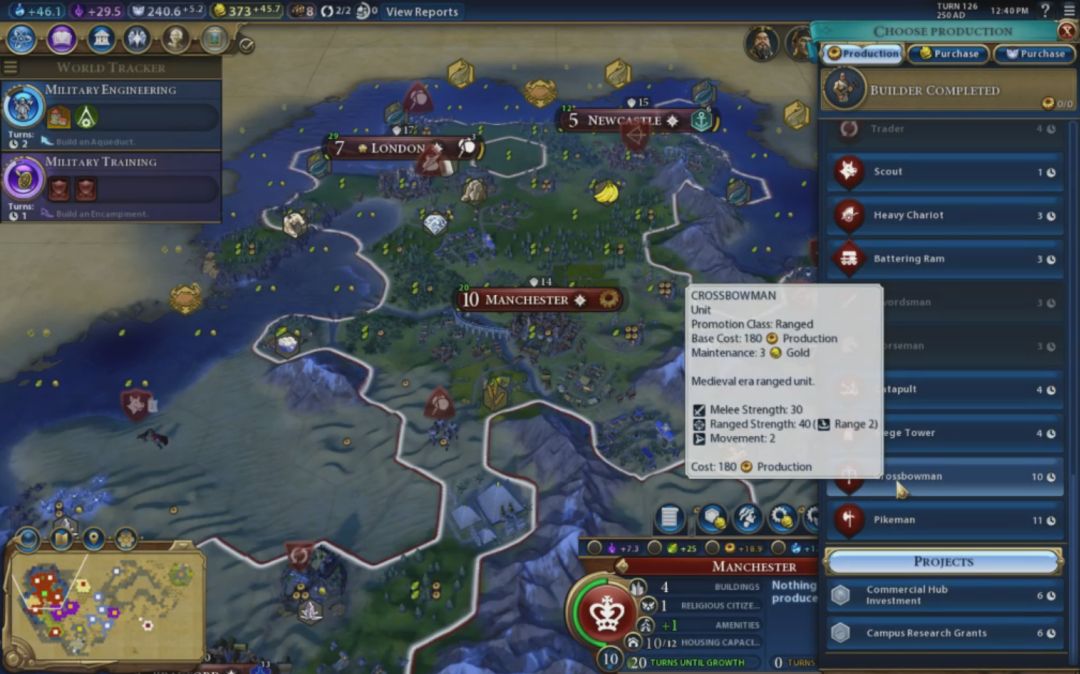
Here's an example of what units look like as they scale up with additional technology. Archers are the basic ranged unit (after slingers), able to shoot 2 tiles away with a ranged strength of 25. They upgrade to crossbows, which have the same range and a strength of 40. However, note the jump in cost for this second-tier unit: 180 production for one unit? That's a lot. Compare the 10 turn build time for a crossbow to the 3 turn build time for a swordsman, and keep in mind that archers are cheaper units than swords. Crossbows are therefore 60% stronger than archers but cost about 300% more than their early game cousins. This is another baneful effect of the One Unit Per Tile rules, as units have to get vastly more expensive to avoid the map being unduly cluttered with units. I don't see any way around this either. The net result is that it's much better to build cheaper old units right before obsoleting them, and then upgrade them with gold, rather than build the new units. Gold is easy to get in this game while production is limited. Build the cheap units before they disappear and then upgrade - don't build shiny new units in most circumstances.
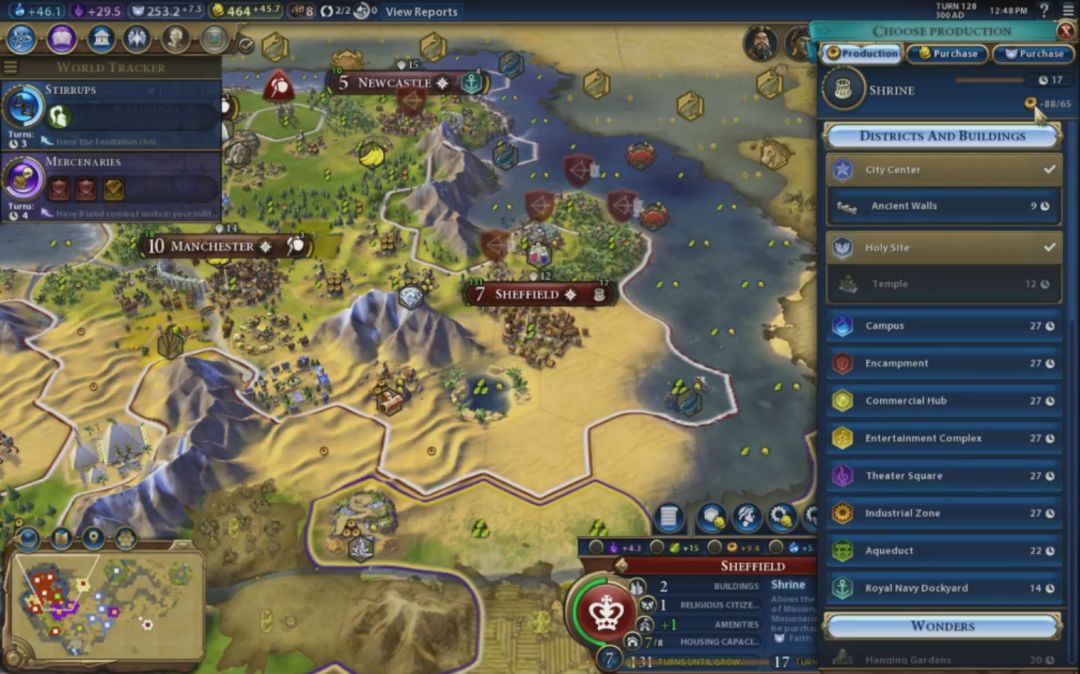
This was... interesting. The one lasting effect of that war with Kongo had been a single pillaging, at this Holy Site district next to Sheffield. The district was located on the tile northwest of the city, next to the mountain for the adjacency bonus. When the tile was pillaged, I had an option to rebuild it on the city menu, and I did exactly that. Then I went back to working on a shrine in the city, and the interface stated that it was sitting at -88/65 production?! That might be a bug there. I think that the game included the district repair cost in the build time of the shrine, somehow forgetting that I had already separately repaired the Holy Site on its own. As a result, this turned into the world's slowest shrine build ever, and I would never get close to founding my own religion in this game. It was probably worth it just to see something this silly pop up in the game.

I took this screenshot to demonstrate the upgrade process in action. There's a policy that reduces unit upgrade costs by 50% (Professional Army: free Leonardo's Workshop from Civ3), and I've found it to be a very handy one in the few games I've played thus far. Turning archers into crossbows only costs 100 gold here with the discounted upgrade, for example. You could probably come out with a net profit right now by building units, upgrading them with this policy, and then disbanding the upgraded units. (Disbanding units currently provides obscene amounts of gold; this is almost certainly a bug. I avoid abusing this in my games.) I was essentially out of land for expansion at this point, and I was thinking that it might be interesting to upgrade my units and then sail across the water to attack Mvemba. He had declared war on me earlier, after all, and he still only had one city to his name off to the east. I needed to experience offensive warfare at least a little bit in this game to get some practice for other games down the road. The Kongo seemed like an easy target. Rome would have been my preferred victim due to geographic proximity, however Trajan had pretty much been my only friend all game, and I didn't want to break that relationship. Lucky for him.
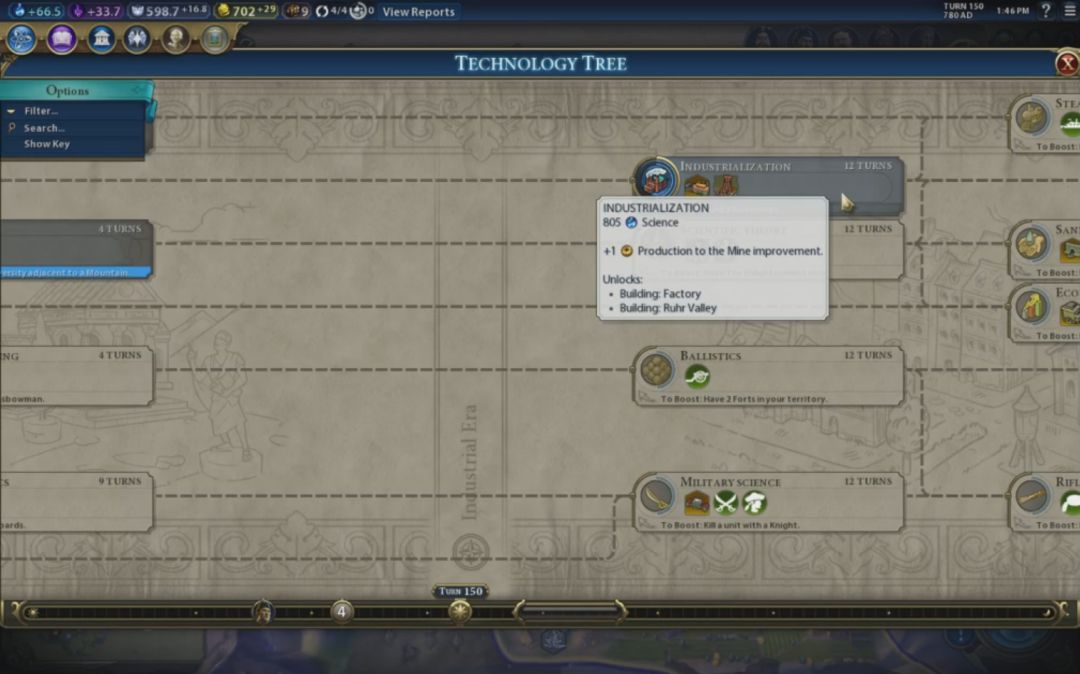
This was my current beeline on the tech tree, heading towards Industrialization as soon as possible. Even here in my first game, I'd already figured out how good this tech can be, between unlocking factories and getting that second +1 bonus to the mine tile improvement. You can beeline pretty deeply in Civ6, as there aren't a lot of cross-tree requirements, and if you have the boost associated with the tech it can often be cheaper than one might think. The neat thing about factories is that they can affect multiple cities: each factory adds +3 production to all cities within 6 tiles. This effect stacks with multiple Industrial districts carrying multiple factories, making it a good idea to have these things essentially everywhere. Industrial districts might be a little too good right now, as I'm struggling to think of a scenario where I wouldn't want one at a city. In any case, definitely get factories going to help construct everything faster.

My army set sail across the small channel to the east right around Turn 150. That was when I noticed this popup about a broken promise with Rome: "your promise to move troops on the border has been broken." Say what? I clearly did not have any units on the Roman border. Anyone with a pulse can tell that my army is heading for another target entirely. However, it turned out that I did have a single unit next to Rome's borders: my starting warrior, who had been fortified in an unclaimed patch of land to the south for anti-barbarian fogbusting purposes. Rome's borders had expanded over time and the warrior was now next to Roman territory. The diplomatic AI somehow interpreted this as a hostile act. Apparently it can't distinguish between an invading army and a single extremely outdated unit sitting in an unclaimed part of the map.
Rome had been friendly the whole game. Even in the screenshot above, Trajan still has the green happy face on his portrait. And yet this action of mine, sitting a warrior in vacant deserts near his borders, this action was apparently so insulting that he threw our longstanding relationship away and declared war a mere four turns later. 
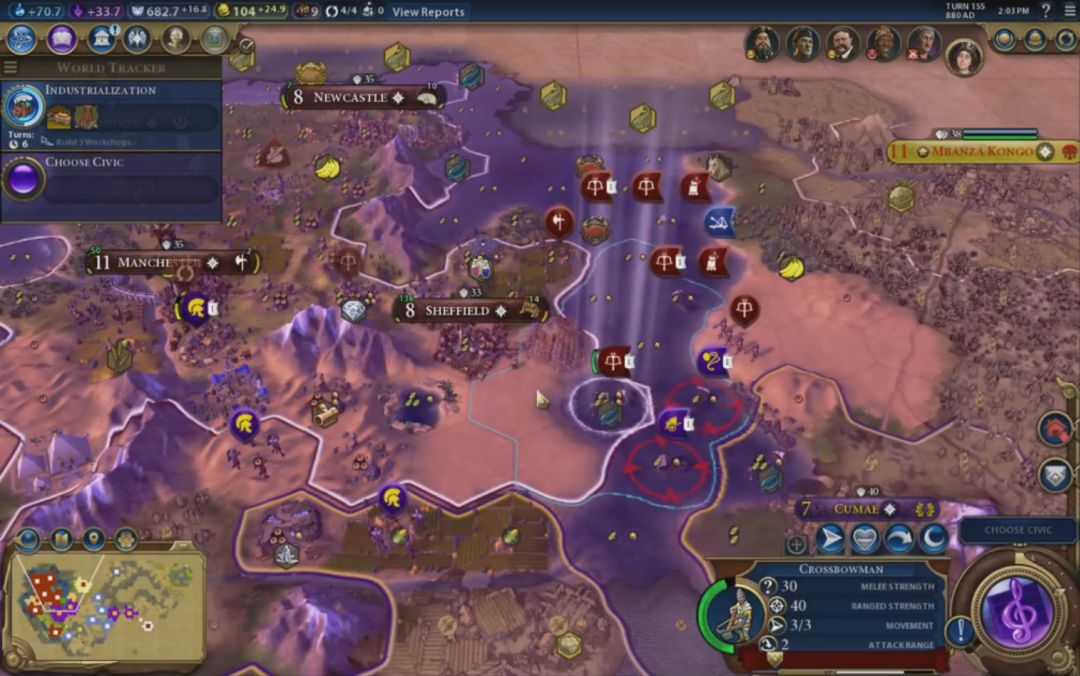
I had not recalled my units because I couldn't possibly believe that Trajan would actually declare war over something this trivial. Now they were stuck out in the water, preparing to assault another civilization entirely. Great, just great. Trajan outsmarted me through sheer stupidity!
If the AI had any idea how to play this game at the military level, this could have been a dangerous situation. None of my cities had walls for defense, the Roman unique unit legions are quite powerful at 40 strength, and it was going to take a few turns to bring my army back to the home shores and get them into fighting position. A coordinated attack could have potentially taken Manchester or Sheffield here. Instead, Trajan's units predictably shuffled around in circles without doing anything of consequence. I think that one of them eventually pillaged the Campus district at Manchester, and that would be it. None of the legions ever launched an attack against one of my cities despite having ample opportunity to do so. Why are these units so passive? The combat AI appears terrified of ever taking any damage and as a result simply does nothing. Soon enough my units had returned from the eastern sea, followed by English crossbows shooting down all the legions in a flurry of bolts. I mean, good for me in the context of this game, but certainly not good for the larger state of Civ6. Something needs to be done about the combat AI.
One other issue to mention: Rome's units appeared to be able to use my roads while being at war with me. There were two separate occasions where a legion walked onto a hill tile and then moved again afterwards, which should not be possible. I don't think there are any melee unit promotions that allow them to move quickly through hills, right? Then there are these other stories about how players are using Open Borders agreements to walk up to enemy cities and then declare war, without being teleported away, in the old Civ3 "Right of Passage Rape" fashion. I don't know what's going on here, but it certainly doesn't look good. More bugs I guess.
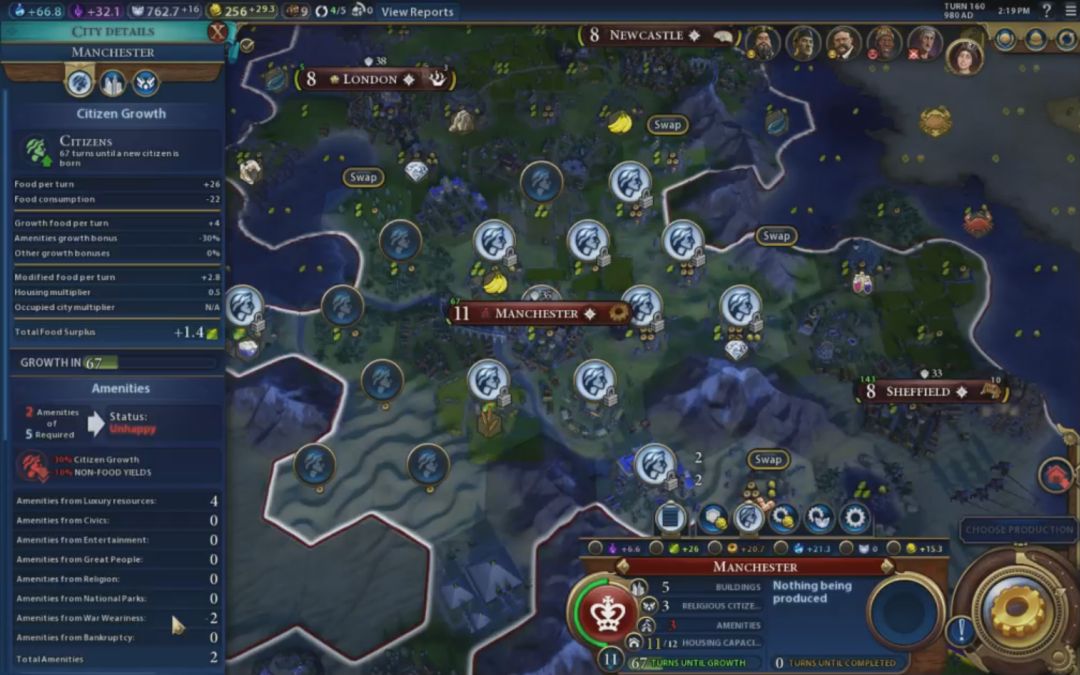
Although Roman units posed no threat, I quickly found my cities plagued by war weariness. Note that Manchester here has -2 amenities from war weariness; this would grow to -5 war weariness before the conflict concluded. The mechanic for how war weariness is generated remains a mystery for the moment. It definitely feels too high, however, since I was seeing this penalty while fighting in my own territory against a foreign invader. What am I supposed to do, let Rome capture my cities? It's baffling to me that you accrue war weariness while defending your own cities in your own borders. In Civ4, for example, the player never amasses war weariness while fighting in their own territory, only by engaging in combat outside their borders. There's even a policy in this game that removes all war weariness from fighting in your borders (Defense of the Motherland), however it doesn't become available until near the end of the game. That should be the default state! And the only other policies related to war weariness reduce it by -25% (there are two of them that do the same thing, Propaganda and Martial Law). There is no way to take war weariness out of the game completely, absent modding. This small corner of the gameplay is another badly tuned area; the numbers for war weariness are set way too high right now, and there are virtually no options to get rid of it. I hope that Firaxis will take another look at this.
There are similar diplomatic penalties associated with declaring war in Civ6. The game uses an era system whereby declaring war carries greater and greater penalties as technology advances. The idea is that the world becomes more civilized over time or something like that. As a historian myself, I would challenge that assertion, since the largest and most destructive conflicts in the history of humankind happened in the past century during the "modern" era. Just because the past few decades have been peaceful is no guarantee that the next few decades will stay the same way; most Europeans in 1900 thought that peace and prosperity was the default state of things, only to be rudely disavowed of that notion during the horrific 1914-1945 period. "Civilized" nations seem perfectly capable of invading one another in this very present day and age. But to take this back to Civ6, the diplomatic penalties for declaring war also seem to be set far too high. Much like war weariness, attacking another AI civ for any reason after reaching the Industrial age will make everyone hate your empire, even if they also hated the nation you attacked. Some of the other Adventure One reports had examples where the player was asked to declare a joint war, they agreed, and then their alliance partner denounced them for declaring war!  Craziness. Whatever numbers the current system has in place need to be turned down, way down, no, further down than that. I'm hoping the whole diplomatic system gets an overhaul in patches because it's in such a shambles at present.
Craziness. Whatever numbers the current system has in place need to be turned down, way down, no, further down than that. I'm hoping the whole diplomatic system gets an overhaul in patches because it's in such a shambles at present.

I intended to punish Trajan for his stupidity, and taking the city of Rome looked like an appropriate penalty. The river to the north of the city and the hilly terrain surrounding it made this somewhat difficult, however. I had trouble getting my units into position to attack without getting jammed on top of one another. More fun with One Unit Per Tile, yay. I also found that my crossbows weren't particularly good at attacking the city; I did know that there was an archer/crossbow penalty against cities, just not that it would be this large. Due to that -17 penalty, the crossbow shots were only dealing about 10 damage apiece, and cities have 200 health. With city walls in place, Rome was a tough nut to crack. I had built two siege towers ahead of time to help me out, and found them to be almost useless in practice. Siege towers allow melee units to ignore city walls - they don't actually reduce the walls themselves. Argh. What I actually needed here was siege units, catapults and bombards, which get major bonuses against city defenses. When I had the chance to use a catapult in a future game, I was almost stunned at how easily it knocked out city walls. Instead, in this game I spent long turns beating my head against the walls of Rome. Well, lesson learned. I didn't bring the right unit mix to the party. I'll make sure to remedy that in the future.
This was the only city I attacked all game, and the AI did a solid job of defending itself. It was such a contrast to what I read in a lot of the other Adventure One reports, where the AI was run over by tiny armies, in some cases as little as 2 archers and 1 warrior. Now that's partly because this is only Prince difficulty and the AI doesn't get enough bonuses here, but I think the larger reason relates to the presence or lack of city walls. They make a giant difference; without them, the AI gets trounced by the player with little effort. With them, the player has to muster a genuine force to push through. If I were doing the AI city building algorithm, I would heavily emphasize the AI building walls in all cities. The AI must be able to defend itself credibly above all else. Right now, the AI is getting rushed with ease in the opening turns even on Immortal difficulty, and that should not be allowed to happen.
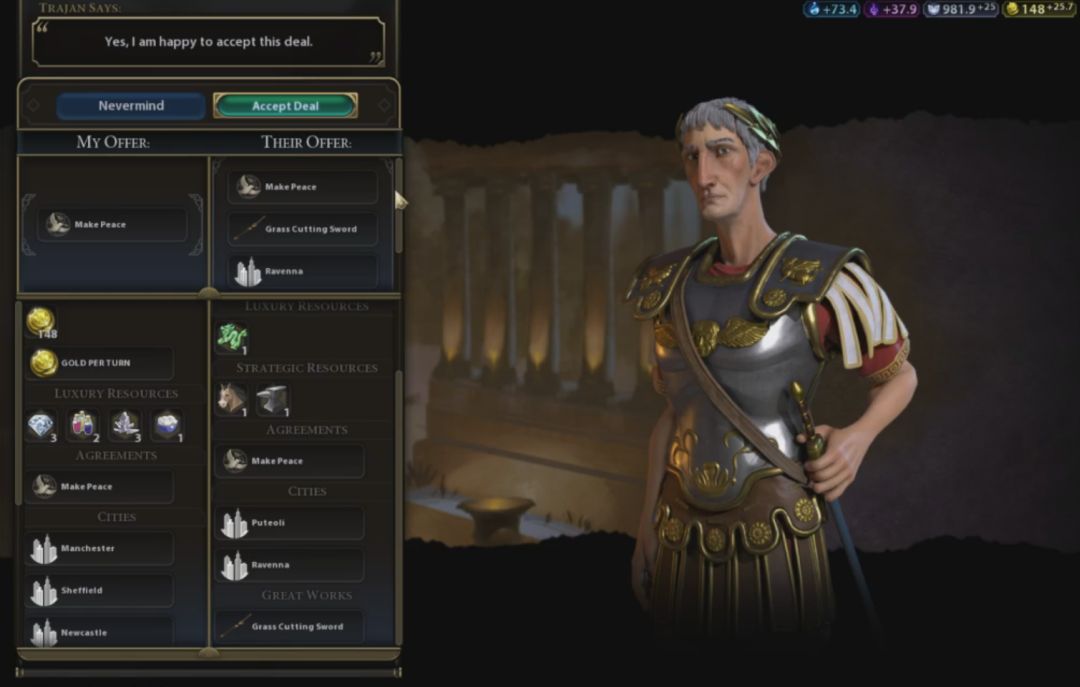
I signed peace with Trajan after capturing Rome. I never lost any units in this war, or in any wars throughout the whole game. Mostly the conflicts in this game served to waste time for no real reason. This is the diplomatic trading screen in Civ6, and wow, does this one ever have problems too. Almost all of the important information is once again hidden under various different submenus (not pictured here), and there's no diplomacy overview screen at all. The player must check each AI leader one at a time to see their relationships with one another. I continue to be baffled by the atrocious interface design. It is really that hard to create a diplomatic leader matrix? Civ3 seemed to have no problems doing this back in 2001. It's not rocket science!
Trajan was willing to cede me the cities of Ravenna and Puteoli in the peace treaty, along with a relic that he had in his palace, the "Grass Cutting Sword". I had no real idea what this did, but sure, why not. Let's take your pretty sword too. I now know that relics are essentially another form of the various Great Works that come from Great Artists/Writers/Musicians. They can be put on display and generate some combination of culture, faith, and tourism. I should also mention that the trading screen is currently very badly bugged, and repeatedly asking for "what would make this deal work" can convince the AI to send the player thousands of gold for free. Obviously I don't use this exploit in my games, and I expect it will be fixed soon in patches.
One thing that I did not get in the peace deal was an official cessation for the city of Rome. It wasn't even an option on the peace screen; I probably needed to wait a turn before signing peace to get it to appear diplomatically. That would end up having repercussions for the city of Rome:

Because Rome was not ceded to me in the peace treaty, it remained an "occupied" city. These locations are stuck at their current size and cannot grow further; I think they get other maluses to city output as well. Note how Rome is only getting 5.9 production even though I'm working 9 production from tile yields. As a result, the city of Rome would remain one of the weaker parts of my empire, unable to capitalize on its excellent local terrain. In order to remove this penalty, I would need to get Trajan to cede the city to me in a peace deal, or eliminate Rome entirely as a civ from the game. Since I was hoping to avoid more conflict with the AI empires, I had to live with this situation. I don't really mind this as a mechanic overall, and it's certainly a lot better than the puppeting stuff that Civ5 was trying to foist on the player. The AI seems willing to cede captured cities from what I can tell, and if not, there's always the option of simply wiping them out.
When I checked the game standings at this point, I was even further ahead than before, well over double the score of the next closest AI empire. Although I had been enjoying the game, victory was clearly a foregone conclusion at this point. It was time to start figuring out the fastest way to achieve a victory condition and move on to greater challenges. After looking at the different options, it became clear that Culture was going to be the easiest way to conclude this venture:
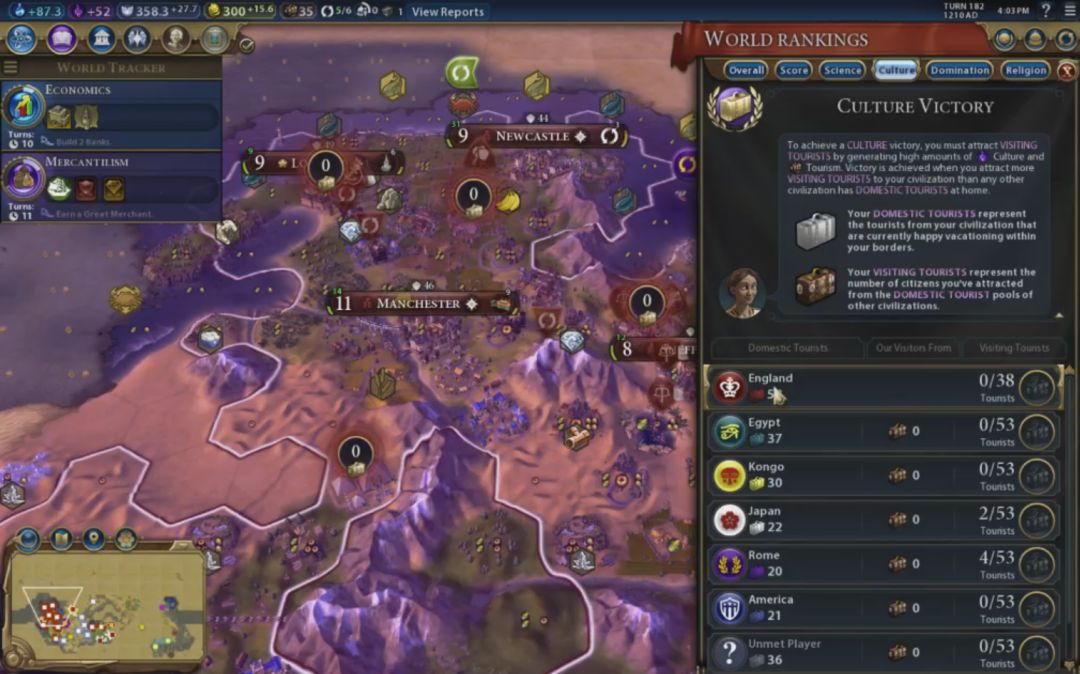
Religious victory was out since I had never founded my own religion. Conquest would require capturing 6 more capital cities, and I did not want to go through that grind. Spaceship would necessitate finishing the entire tech tree, followed by building the insanely-expensive spaceship parts. (Seriously, 3000 production each?! Are you kidding me Firaxis?) Researching the whole tech tree and then hitting "Next Turn" for 30 more turns waiting for the spaceship parts to be completed sounded like a form of slow torture. No, it was going to have to be Culture, a victory condition that I knew almost nothing about, only that it involved accumulating tourism in some fashion. I was currently sitting at 0/38 tourists, and apparently filling up that meter would result in victory. New mission: start looking up things that produce tourism on the tech and civic trees and start researching towards them.
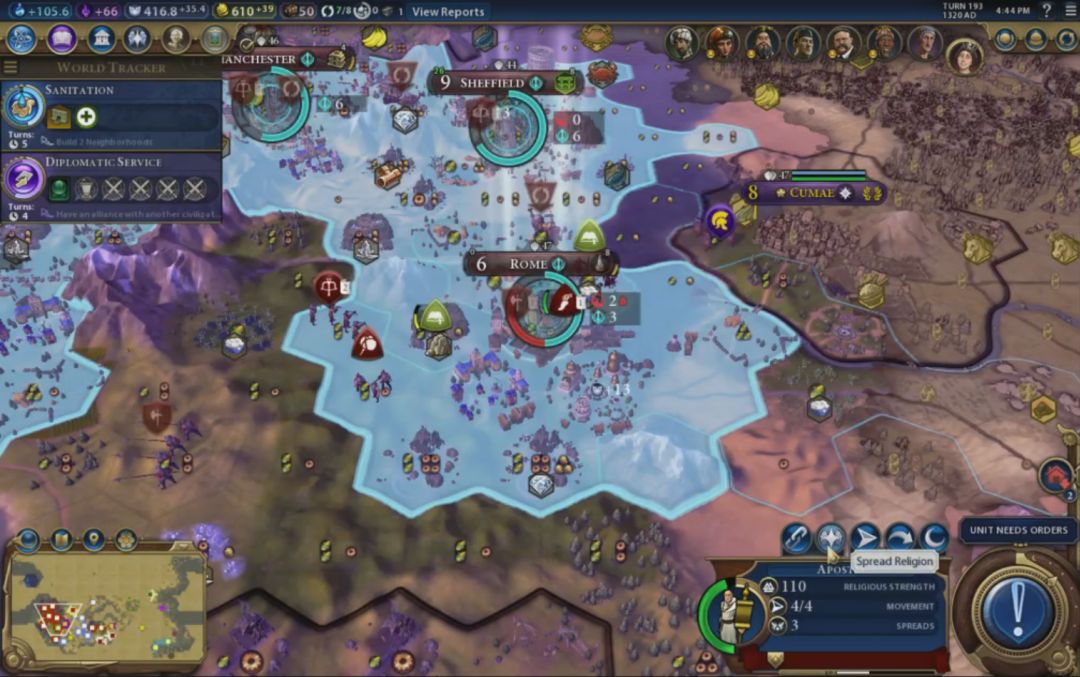
Speaking of missions... I began to see a flood of Chinese missionaries trying to spread Taoism into my territory. Rome had been the Holy City for Sikhism, and I had spread that religion to a couple of other cities. These Taoist missionaries were not welcome in my lands. However, I had so little faith that there wasn't a whole lot I could do to keep them out. Missionaries and apostles can move through territory without Open Borders, and the only way to stop them is to engage in religious combat. Even in the small number of Civ6 games that I've played thus far, I'm already finding the AI's endless spamming of missionaries to be tedious, especially because they count as military units for stacking purposes and can block your units from entering a tile. Really annoying when that happens. While the religious side of Civ6 isn't bad necessarily, it's definitely very micromanagement intensive and can get boring in a real hurry. Was it a good idea to have religion be so dependent on moving missionaries around the map? Probably not. We'll see how I feel about this in a few months.
OK, so how exactly does one increase tourism in Civ6? Some of it comes from wonders, and I would indeed build more wonders as the game continued to chug along. The Pyramids in particular had been very helpful to have; anything that improves builders is worthwhile to have. However, you can't do it all with wonders, and a lot of tourism needs to come from relics or Great Works... or artifacts.

Oh god. Not the archaeologist units!  Are we really doing this? I supposed that we are. For those who are wondering what this means, I was highly critical of the introduction of the archaeologists in Civ5 Brave New World. I wrote that this was tedious time-wasting fluff that had no place in a grand strategy game. I still feel that way, and I don't like the way that Culture victory is implemented in Civ6 at all. Why is Culture victory dependent upon building archaeologists and moving them around the map to dig up artifacts in these antiquity sites? Now that culture has its own research tree, couldn't the victory condition be based around researching to the end of the tree and then building a final project of some kind? You still have to amass lots of culture under the actual system used in Civ6, it just involves a lot of really pointless micromanagement of units to go dig up these artifacts. Ugh.
Are we really doing this? I supposed that we are. For those who are wondering what this means, I was highly critical of the introduction of the archaeologists in Civ5 Brave New World. I wrote that this was tedious time-wasting fluff that had no place in a grand strategy game. I still feel that way, and I don't like the way that Culture victory is implemented in Civ6 at all. Why is Culture victory dependent upon building archaeologists and moving them around the map to dig up artifacts in these antiquity sites? Now that culture has its own research tree, couldn't the victory condition be based around researching to the end of the tree and then building a final project of some kind? You still have to amass lots of culture under the actual system used in Civ6, it just involves a lot of really pointless micromanagement of units to go dig up these artifacts. Ugh.
While I was slowly heading in that direction on the culture tree, Teddy Roosevelt began moving a mass of outdated trash units around my borders. It was downright comical how heavily he telegraphed that he was planning on attacking; I wasn't sure that he actually would declare war because it was so incredibly obvious that I didn't think even the AI would be that dumb. He also took his sweet time about it too, walking around my borders for almost a dozen turns before finally giving the invasion order. Not the finest moment for the AI here.

America had a lot of units. A lot of laughably outdated units. Everything seemed to be some combination of chariots, catapults, and... warriors?! 
 Yep, Teddy was actually sending warriors after me 200 turns into the game. That was pathetic, to the point that I almost felt sorry for him. The issue here appears to be upgrade paths, as warriors upgrade into swords (and nothing else), but swords require iron and if the AI doesn't have the strategic resource, it never upgrades its units. Ditto for chariots into knights, and catapults into bombards (which I think require the niter resource). This seems to be a common problem for the AI, and since they don't do well at acquiring strategic resources, Firaxis would do well to rethink the upgrade path for units. It's unseemly to have warriors running around everywhere this late in the game.
Yep, Teddy was actually sending warriors after me 200 turns into the game. That was pathetic, to the point that I almost felt sorry for him. The issue here appears to be upgrade paths, as warriors upgrade into swords (and nothing else), but swords require iron and if the AI doesn't have the strategic resource, it never upgrades its units. Ditto for chariots into knights, and catapults into bombards (which I think require the niter resource). This seems to be a common problem for the AI, and since they don't do well at acquiring strategic resources, Firaxis would do well to rethink the upgrade path for units. It's unseemly to have warriors running around everywhere this late in the game.
City states have the same problem too, as they're even less likely to have the strategic resources they need to upgrade and build modern units. Note how Zanzibar is stuck employing warriors and chariots too. As a result, because unique units in Civ6 never have resource requirements, it's AI empires like Rome and Kongo with UU sword replacements that often pose the biggest threat. Trajan can actually upgrade his warriors into legions without having iron on hand, and that seems to help out a lot. This is yet another area that I hope gets more attention going forward.

This is the Great Works screen, where all of the various tourism-producing stuff gets stored. Much of the Cultural victory planning involves having enough slots to "display" all of the various cultural relics and works and artifacts for tourism purposes. I find this whole concept to be an example of poor design; if I produce a Great Artist, I shouldn't need to micromanage having "art museums" to house the subsequent paintings. That should be abstracted, and I should simply receive the benefits of the paintings immediately. It reminds me a little bit of having to manage your quantity of arrows for bow/crossbow characters in Diablo 2. Maybe it's more "realistic", but it's mostly tedious micromanagement that serves no purpose. This Great Work system is a classic example of complexity that lacks any real depth or interesting strategic choice.
This screen does show the English unique building, the British Museum, which is confusingly referred to as an "Archaeological Museum" here (and also in the city build screen). Normally these museums have space to store three artifacts, while the British Museum instead gets six artifact slots. Like I said initially, helpful for a Cultural victory attempt and not very useful for anything else. If I could build some archaeologists and have them dig up enough artifacts to fill those slots, it would do a great deal to speed me along to a Cultural victory via increased tourism.
Yes, that really is how to achieve a victory condition in Civ6. Not joking about this. 
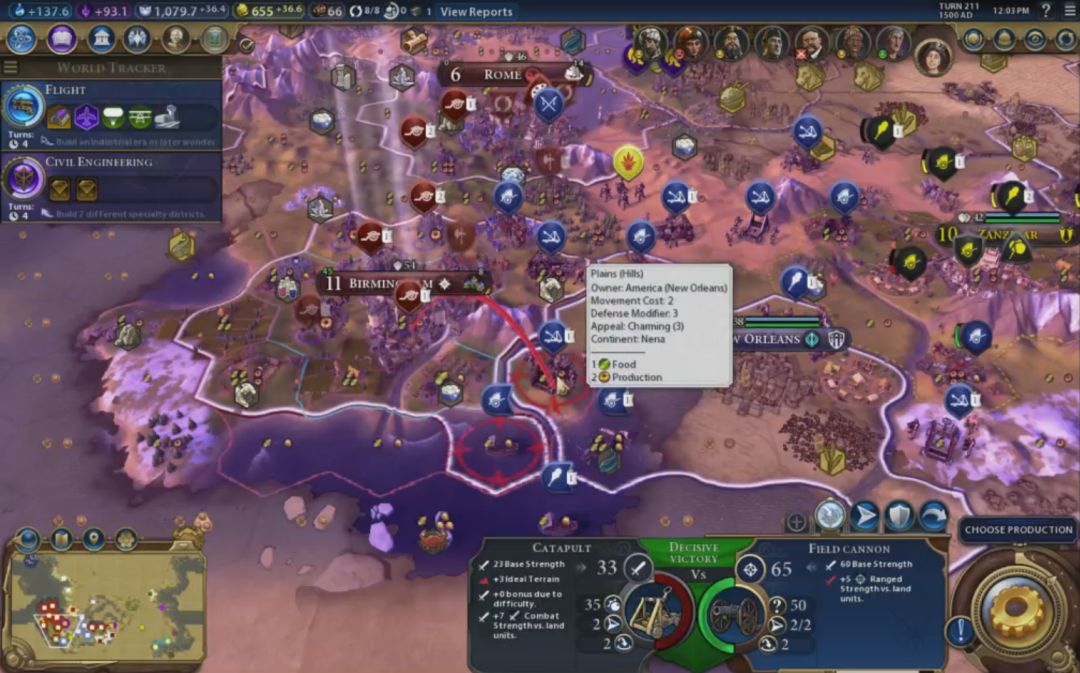
Oh yeah, technically there was still a war going on, although that could be more accurately termed a one-sided slaughter. I had upgraded my crossbows into field cannons (ranged strength = 60) and they were one-shotting most of the American units. I guess that's what would have happened if the United States had tried to field chariots and catapults during the Revolutionary War. (For some reason, I'm picturing George Washington driving a chariot right now and finding it very amusing.) I don't have a lot more to say here, as my units easily carved a path through the detritus of Ancient era opposing units and pressed forward. I punished Teddy by capturing the city of New Orleans, which he was willing to cede in the subsequent peace treaty. Let's get this pointless conflict over and move on to other things.
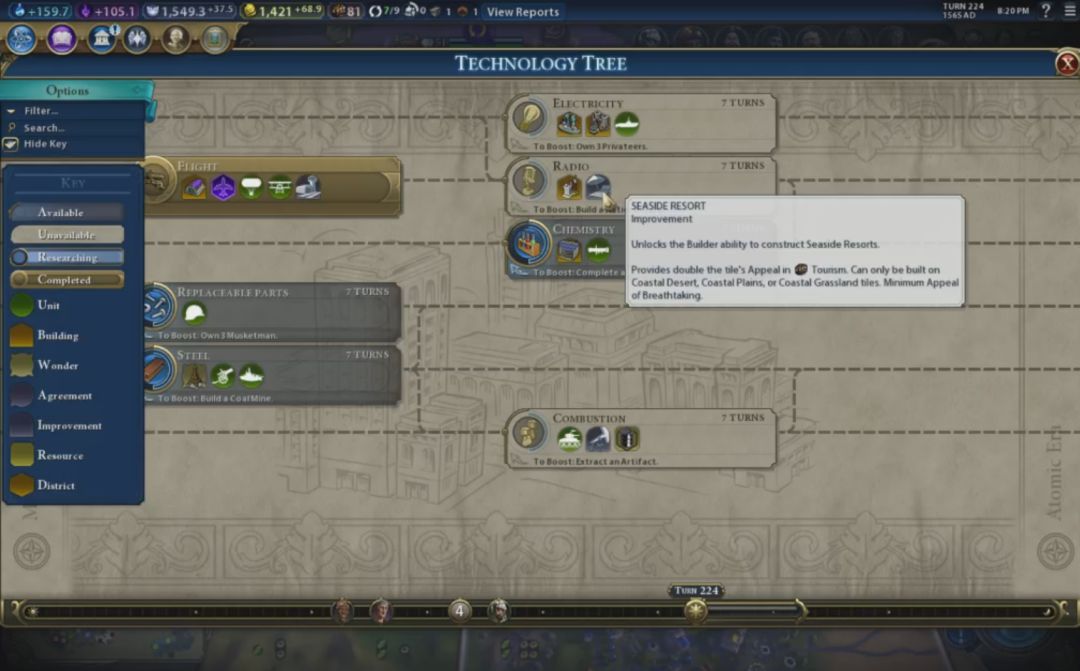
I saw another tourism-related item on the tech tree at Radio, and decided to head there next. This opens up the possibility of constructing the "seaside resort" tile improvement, which apparently adds a small amount of tourism to your empire's total. There are very strict requirements for building these things: the tile must be coastal, it must be grassland/plains/desert, and it must have an appeal of "breathtaking". What the game doesn't state anywhere in the tooltips or Civilopedia is that the tile must also be flatland and not a hill. I could not understand this while playing and only found out afterwards; seems like the kind of thing that should be documented in-game somewhere, right? While I wasn't terribly interested in another gimmicky minigame, I needed more tourism. Bring on the seaside resorts then.

This is an example of the archaeologist (sigh) units in action. After researching the natural history civic, various ruins locations will appear on the map in seemingly random places. They never appear on improved tiles, however, which is why there were essentially none of them in my territory. (On the other side of the coin, there were... a lot of ruins in AI territory. A lot.) The player moves an archaeologist unit into the tile with the ruins, the archeaologist digs up an artifact, and it gets placed in one of the museum slots on the Great Works screen. Each artifact seems to be worth 3 tourism, and potentially more if the whole museum is filled up for the "theming" bonus. Since the books and paintings produced by Great Writers/Artists are worth 8 tourism apiece, these artifacts are pretty important for a Cultural victory. Three of them together are slightly better than a Great Work produced by a Great Person. If you have the patience to walk them around the map exploring the dozens of ruins sites that pop up, it can mean a whole lot of tourism. (Can I sigh again to demonstrate how ridiculous this whole concept is?)
By the way, the ONLY way to remove ruins from a tile is to use an archaeologist. Tiles with ruins cannot be improved in any way until the ruin is removed, so don't think you can mine or farm a tile where a ruin pops up. For this reason, I would stay the heck away from the Natural History civic unless you're planning to go for a Cultural victory. Archaeologists are not cheap units, and the ruins can get in the way of your city planning.

Here's a picture of one of the new "lenses" in Civ6, this one showing the appeal of each tile. Appeal is supposed to represent how desirable it would be to visit or live in a particular tile, and it's used for tourism and the housing provided by the neighborhood district. There are a number of other lenses as well, with the most useful one typically being the settler lens to highlight which locations have fresh water and which tiles are ineligible for city placement. I like the concept behind these lenses and hope the Civ6 development team keeps working with them further.
For tourism purposes, I could only build seaside resorts on the bright green tiles with Breathtaking appeal. I could also only build them on the coast, and not on hill tiles, and not in the tundra (which would have been hilarious). That worked out to only 3 or 4 total tiles, and as a result the seaside resorts did not amount to much in terms of tourism. It was still better to have them than not have them though, so of course I built them.
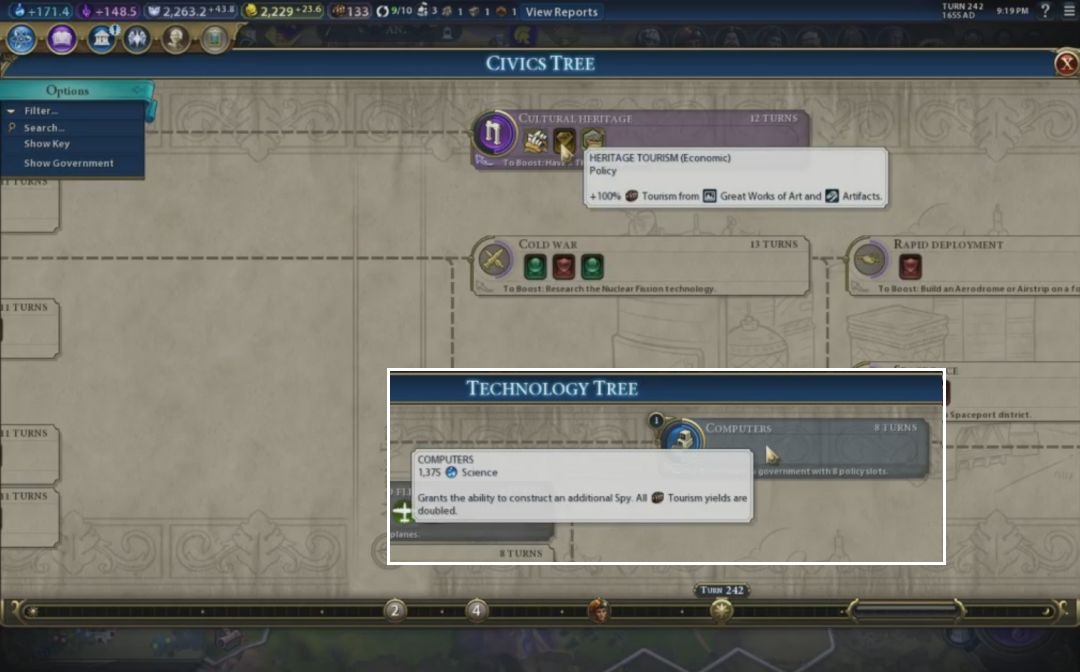
Here are the real drivers of tourism: the Cultural Heritage civic and the Computers tech. Both of them are deep in their respective trees and near the ending points; Cultural Heritage is actually the very last civic at the top of the culture tree. However they can both be reached on pretty serious beelines, and I would likely do a more determined effort to head straight for these two if I were going for a Cultural victory again in the future. Cultural Heritage has the highlighted policy that doubles tourism from artifacts and Great Works of art. (Why not Great Works of writing and music? They have separate policies it seems.) These will likely be providing a substantial amount of your overall tourism and this policy is obviously well worth adopting. Computers tech is even simpler: all tourism yields are doubled. Nice and simple. There are other policies in the culture tree that also boost tourism significantly: Satellite Broadcasts (triples tourism from Great Works of music) and Online Communities (+50% tourism output to civilizations to which you have a trade route). They are harder to reach on the culture tree though, since most of the culture/tourism stuff is at the top of the tree and they are at the bottom, plus they require going through more total civics to unlock.
Anyway, I don't think this comes as brilliant strategic advice. Obviously you should adopt the policies that boost tourism when pursuing a Cultural victory. Only the best strategies from this website! 
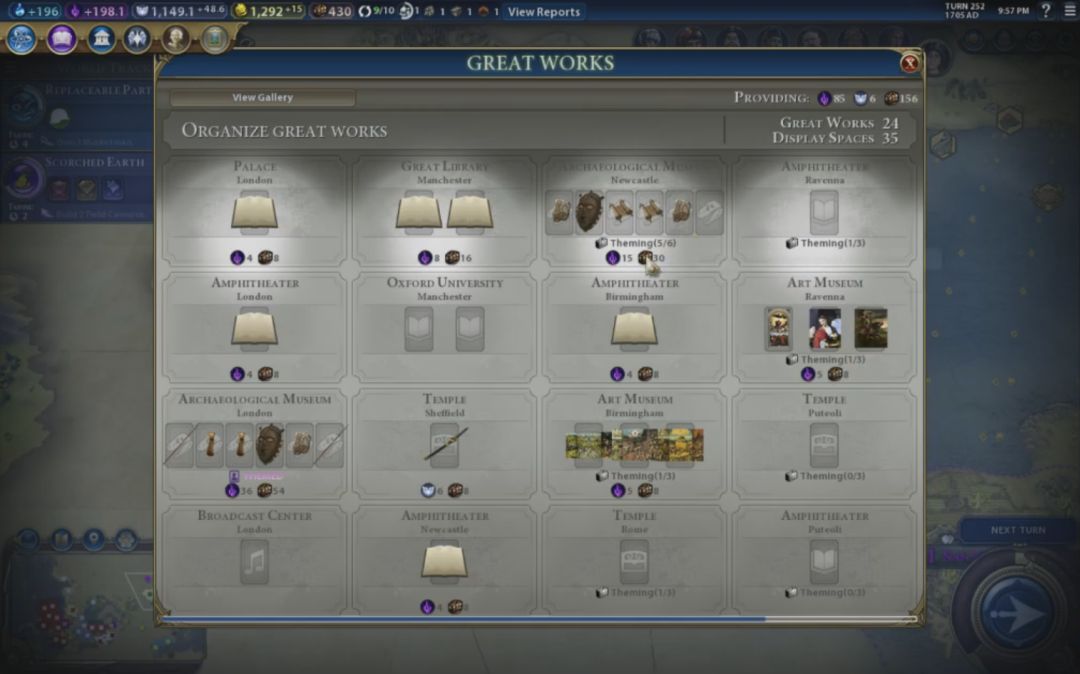
In the previous screenshot, I was getting 133 tourism from various sources. Ten turns later, after finishing Cultural Heritage civic and Radio tech, my tourism had ballooned to well over 400 per turn. Hopefully my tourism rate was approaching terminal velocity here. I also used this image to demonstrate what the Great Works screen looks like as it continues to be filled up. There's actually a scrollbar down there at the bottom, with space for more cultural artifacts to be put on display off this screen. Note that the artifacts dug up by those archaeologists were providing 84 of the 156 tourism, more than half of the total. Unfortunately you can't ignore that particular minigame if you want to win with any kind of speed.
I had been at roughly 80 tourism only 20 turns earlier. With tourism having exploded upwards via an increase of some 400% since then, I knew it wouldn't be too much longer before victory arrived. This was the status on Turn 255:

Still less than halfway? That was disappointing. I dislike how this victory condition is based on your performance vis a vis the other AI empires, as a lot of the outcome is outside of your control. (Short of attacking and killing the AI leader in question, of course. That's technically always an option.) Arabia was in second place for tourism behind Egypt, and I would have needed only 62 tourism to win the game against them. Egypt's tourism was slowly me down significantly here... somehow. I don't really understand how Egypt's 18 tourism/turn is holding out against my 490 tourism/turn.
That's probably my biggest complaint about this whole victory condition, aside from how unnecessarily micromanagement-intensive it is. The entire Cultural victory is completely opaque to the player. Yes, of course I want to get as much tourism as possible. I understand that I need to fill up that ratio on the right side of the screen to win. But where are these numbers coming from? Why do I have 44 tourists on this screen? What is the formula where that comes from? Why do I need 103 tourists to defeat Egypt? Nothing is explained and all of the numbers seem to be pulled from the ether. If Firaxis wanted to make the Cultural victory based on tourism, then how about this: the first civilization to attract 10,000 tourists wins the game. Isn't that infinitely simpler to understand? There's a clear target, I can see my progress towards the goal along with how close everyone else is, and the victory makes logical sense when achieved. The victory condition as currently designed is a total black box, and the numbers required to win seem to shift around in amorphous fashion on a turn-by-turn basis. The design here could be, should be, better.
At this point, with my civilization producing 27 times the tourism of the second-place civ, victory was a foregone conclusion. I turned off the animations and clicked next turn a bunch of times, leading to this:

I tipped over the mark on Turn 278. I did enjoy producing over 600 tourism/turn at the end of the game, that was fun to see. Somehow I only had double Egypt's number on the little suitcase, even though Cleopatra never managed to produce more than 18 tourism. Egypt delayed my victory by at least a dozen turns here; no one else was even remotely close. I have no idea why the game considered them to be so strong in terms of tourism. Perhaps I'll understand more about this system with time.
I assumed the Culture victory would take place immediately. Instead, I had to click Next Turn to get it to trigger. That was a little different from past Civ game, but no big deal. Winning the game caused a victory movie to play - yay! - and then led to this screen:

I'm genuinely happy to see the victory cinematics return, and there seems to be one for all four victory types. Very nice. The static splash screen in Civ5 was such an anti-climactic letdown. Anyway, here are finally the Demographics bar graphs for Civ6, which the game does track while playing. As I said before, I don't know why this information all gets hidden until after the game is over. The rough nature of this screen makes me hope that this is somewhat of a placeholder for an unfinished system still in progress. I highlighted the science per turn graph here, and ooof, that AI performance. I gradually increased in science over time, while the AI empires... did not. They made almost no progress at all from the beginning of the game to the end. If I'm reading that table correctly, none of them were making more than 35 beakers/turn when the game ended. After 275 turns. I'm not sure I can express in words how pathetic that is. Yes, I know, Prince difficulty and all that, but c'mon man!  This is not acceptible.
This is not acceptible.
Overall thoughts time. Civ6 on release is a flawed game. The balancing is poor, there are a lot of exploits, diplomacy is a total trainwreck, the AI makes the Templars from the Apolyton Demogame look like genuises, and One Unit Per Tile remains a terrible fit for the series that continues to cause all sorts of problems. Tom Chick, the reviewer who infamously wrote the only critical review of Civ5, has finished his review of the release version of Civ6, and it's quite harsh. I don't think he's wrong either; almost everything in that article is a legitimate complaint about the game in its current state. If you're on the fence about purchasing Civ6, I think you have very good reason to remain skeptical right now.
With that said... I still like this game. The city building mechanics are excellent, worker builder management and tile yields are back in a big way, Civ6 has returned to being a game of expansion once again, the government/civics system is lots of fun to use, and the various leader/civ bonuses are mostly unique and interesting to play. I'm hopeful that the poor aspects of the gameplay will be improved via patches; one thing that gives me hope is the fact that Civ6 is extremely stable to play, with virtually no reported crashes or stability issues. The charitable interpretation is that Firaxis was working on these issues before launching to make sure they had a stable platform, and now will go back and begin fine-turning the gameplay balance with feedback from the community. This could be completely false, but I hope that's what has been taking place.
But ultimately, even if that doesn't happen, Civ6 provides a solid base to work off of. There's enough good things in the design for me to give Firaxis several patches to iron out some of the problems in the AI, in the diplomacy, and so on. They've earned that much from me. The game also becomes a lot more fun on higher difficulties; a lot of my frustration in this game came from the weakness of the AIs on Prince difficulty level. If that improvement doesn't happen though, Civ6 is a good enough game that we can mod it into something even better, removing the poorly thought out mechanics and doing the balancing ourselves that should have been carried out professionally. One way or another, this is going to become an excellent game in time.
Finally, one last point of comparison. Most of Civ6's problems right now involve the AI in some way, between its seeming total inability to construct its own cities, conduct warfare, or haggle in diplomacy. But most of the mechanics in Civ6 are good systems, even if the numbers might be off right now. This is in contrast to Civ5, where the gameplay mechanics were inherently flawed from the start, and no amount of number tweaking could salvage them. In a nutshell, this is the difference between the two games for me. You can work around poor AI and poor balancing (both can be fixed in time), but it's essentially impossible to work around poor mechanics in the core gameplay. That's why, for me, Civ6 is fun to play while Civ5 was not. Your feelings may or may not coincide with mine here.
I think that's all I have to say for now. Thanks again for reading, and there should be plenty more Civ6 games yet to come. 



